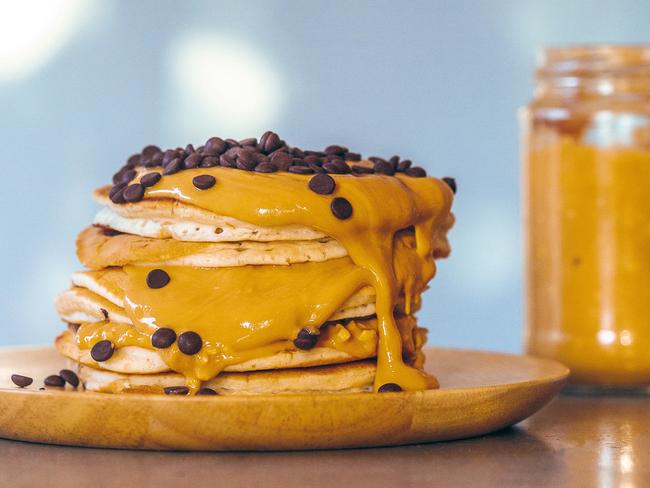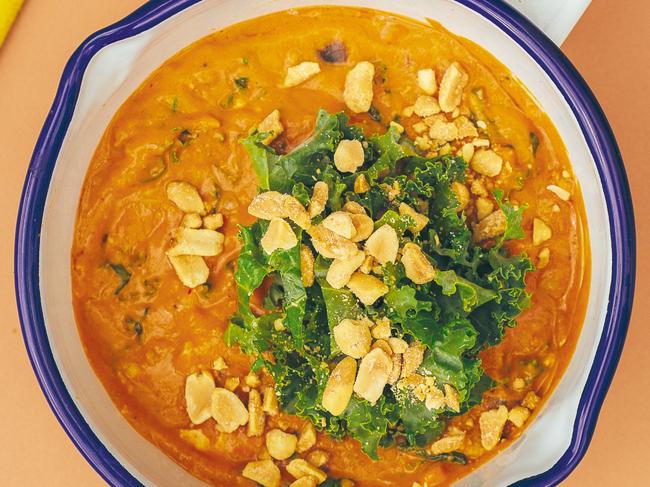All you need to know about peanut butter and how to use it
The thing about peanut butter is it is good to eat for breakfast, lunch and dinner – just try some of these mouth-watering recipes, and see if you’ve got what it takes to win $2000.

Hibernation
Don't miss out on the headlines from Hibernation. Followed categories will be added to My News.
- We’re all in this together: A coronavirus novel
- How birthday girls and boys are celebrating during lockdown
Peanut butter is proving to be a popular comfort food in lockdown that can be enjoyed at every meal – not just breakfast.
Since the Incas and Aztecs first pounded peanuts into a paste, these nuts have found their way into the cuisines and hearts of people worldwide, from Africa to China, Europe and much closer to home.
According to the US National Peanut Board, a version of peanut butter was invented by Dr John Harvey Kellogg (yes, he of Cornflakes fame) around 1895 but it was not until the St Louis World Fare in 1904 that it was introduced to the public.

The rest, as they say …
Like many of us, Tim Lannan first fell for peanut butter as a kid.
“Growing up in North America, my love for peanut butter started young, I grew up on it,” he said.
Unlike many of us, Lannan turned that love into a thriving business, setting up the Byron Bay Peanut Butter Company with his partner, James Annabel, a few years ago.
The duo has just released a book which puts a spotlight on both the humble pantry staple and their obsession with the stuff, Peanut Butter: Breakfast Lunch Dinner Midnight.
As the title suggests, they reckon peanut butter has a place at the family’s table morning, noon and night.

From satays to smoothies, toast to tofu, soups to sundaes, according to Lannan, there is nothing peanut butter cannot do.
“Everyone’s heard of peanut butter cookies, but maybe they haven’t thought of peanut butter spaghetti, or peanut butter nut loaf or making peanut butter and jam ‘sushi’ for the kids,” he said.
“Peanut butter is so versatile we’re just brining some fun to such a popular ingredient.”
SMASH IT UP
Making your own peanut butter is surprisingly easy, given there is little more to it than peanuts and salt.
The key to a great peanut butter comes down to the roast, which helps to release the peanut’s oils and results in a smooth (or crunchy) end product.
In a moderately hot oven (170C) scatter two cups of shelled peanuts on a baking tray.
Roast for about 20 to 25 minutes until golden or darker – the more roasted the peanut, the more intense the flavour.
Cool for at least 5 minutes.
Add to a blender – you will need a strong, good quality domestic blender as the butter is so thick it can burn out smaller motors.
“As long as you’re making the butter in small batches, and adding the peanuts in slowly, it should be fine,” Lannan said.
For smooth peanut butter, blend the peanuts for about five minutes, sporadically turning off and scraping the sides, until you have a smooth creamy paste.
At the end, add 1 to 2 tsp of salt for every 2 cups of peanuts.
For crunchy peanut butter, simply put aside a handful of roasted peanuts at the start and add to the smooth paste to finish.
OIL’S AINT OILS
While most readily available peanut butters are made from imported peanuts, Lannan said it pays to look for premium high-oleic acid peanuts.
“The oil chemistry of these peanuts is similar to that of olive oil or avocado, higher in mono-unsaturated, or good, fats. They’re a more expensive peanut to use, but a healthier peanut,” he said.
TOAST WITH THE MOST
Sure there’s ham and cheese, or popcorn and butter, but as far as famous pairings go peanut butter and jam is hard to top.
When it comes to making the most of your toast, however, it pays to get creative.
“My favourite is peanut butter and pickles, it’s a very American thing,” Lannan said. “I’m not sure if many people have tried that.”
To give it a go, simply add a pickle sliced lengthways into thirds to toast generously spread with peanut butter. Drizzle hot sauce across the lot to taste.
“Smashed avocado on peanut butter is amazing, the creaminess of both work so well together, in terms of texture and taste,” Lannan said.
“Especially if there’s chilli to fuse the flavours together,” Annabel added.
Other twists for peanut butter toast include berry yoghurt and fresh berries, fresh fruit with cocoa nibs, or even toasted marshmallows.
PEANUT BUTTER RECIPES
DREAMY CHOC-CHIP PANCAKES
Breakfast food does not get much better than pancakes. But it can! Add chocolate chips and peanut butter, and you have got something that is worth serving up at any time of day.
Serves 2 to 3 people

INGREDIENTS
185 g (1¼ cups) plain (all-purpose) flour
1 tablespoon baking powder
3 tablespoons sugar
¼ teaspoon salt
250 ml (1 cup) milk of your choice
1 egg, lightly beaten, or egg substitute
60 g (¼ cup) peanut butter, softened, plus extra to serve
100 g chocolate chips or cacao nibs, plus extra to serve
Oil of your choice, for frying
METHOD
• Sift the flour and baking powder into a large bowl, then stir in the sugar and salt. Add the milk and egg and whisk gently to combine. Stir in the peanut butter and fold through the chocolate chips.
• Warm a little oil in a small frying pan over a medium heat and pour in 60 ml (¼ cup) of batter. Cook until small bubbles appear on the surface and the edges start to look dry, then flip and cook the other side for about 3 minutes, until both sides are golden brown.
• Layer your stack with extra peanut butter, top with chocolate chips and serve immediately.
WEST AFRICAN PEANUT SOUP
This is a simple version of the peanut soup or mafé which appears in various forms across West African countries such as Senegal, Gambia and Mali. It is a comforting and cosy winter meal, either on its own or over rice.
Serves 4 to 6 people

INGREDIENTS
1.5 litres (6 cups) vegetable broth
1 large red onion, chopped
3 tablespoons finely chopped
fresh ginger
4 garlic cloves, finely chopped 1 teaspoon paprika
1 teaspoon salt
¼ teaspoon black pepper
200 g protein food (e.g. firm tofu, seitan, meat; optional)
125 g (½ cup) tomato paste (concentrated puree)
185 g (¾ cup) peanut butter
100 g (2 cups) finely chopped kale leaves, plus extra to garnish
chopped peanuts and hot sauce, to garnish
steamed brown rice, to serve (optional)
METHOD
• Bring the stock to the boil in a large saucepan over a medium – high heat. Add the onion, ginger, garlic, paprika, salt, pepper and protein food, if using. Reduce the heat to medium – low and cook for 20 minutes. Add the tomato paste and simmer for 5 to 10 minutes.
• Add the peanut butter, increase the heat to medium and bring to the boil. Add the kale, then reduce the heat to medium – low and simmer, stirring frequently, for about 15 minutes.
• Garnish with extra kale, chopped peanuts and hot sauce, and serve with rice if you wish.
This is an edited extract from Peanut Butter by Tim Lannan and James Annabel published by Hardie Grant Books, $22.99. Photographer: © Kate Berry 2020
BEGA PEANUT BUTTER MASTERS COMPETITION
Bega Peanut Butter is asking Aussies to share their nuttiest, most creative and original peanut butter creations for the chance at winning $2000.
The winner will take home the Australia’s Peanut Butter Master title, with runner up taking home $500 and five others following scoring $100 worth of prizes.
All entrants have to do is whip up a creative peanut butter-based dish using Bega Peanut Butter, submit a photograph of the dish with the jar of Bega Peanut Butter and share the dish to Instagram, sporting the #BegaPeanutButterMasters hashtag.
Entrants will be judged based on merit, creativity, originality and nuttiness.
The competition ends at 11.59pm AEST on June 2.
Originally published as All you need to know about peanut butter and how to use it

